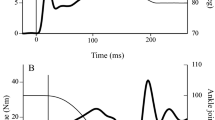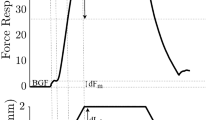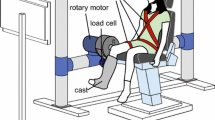Abstract
Reflex responses to unexpected stretches are well documented for selected muscles in both animal and human. Moreover, investigations of their possible functional significance have revealed that stretch reflexes can contribute substantially to the overall stiffness of a joint. In the lower extremity only the muscles spanning the human ankle joint have been investigated in the past. This study implemented a unique hydraulic actuator to study the contributions of the knee extensor stretch reflex to the overall knee joint torque. The quadriceps muscles were stretched at various background torques, produced either voluntarily or by electrical stimulation, and thus the purely reflex mediated torque could be calculated. The stretch had a velocity of 67°/s and an amplitude of 20°. A reflex response as measured by electromyography (EMG) was observed in all knee extensors at latencies of 26 – 36 ms. Both phasic and tonic EMG stretch responses increased with increasing background torques. Lines of best fit produced correlation coefficients of 0.59 – 0.78. This study is the first to examine the reflex contribution of the knee extensors to the total torque at background torques of 0 – 90% MVC. The contribution of the reflex mediated torque is initially low and peaked at background torques of 20 – 40% MVC. In terms of the total torque the reflex contributed 16 – 52% across all levels of background torque. It is concluded that during medium background torque levels such as those obtained during walking, the stretch reflex of the quadriceps muscle group contributes substantially to the total torque around the knee joint.








Similar content being viewed by others
Reference
Allum JH, Mauritz KH (1984) Compensation for intrinsic muscle stiffness by short-latency reflexes in human triceps surae muscles. J Neurophysiol 52:797–818
Allum JH, Mauritz KH, Vogele H (1982) The mechanical effectiveness of short latency reflexes in human triceps surae muscles revealed by ischaemia and vibration. Exp Brain Res 48:153–156
Capaday C (2002) The special nature of human walking and its control Trends Neurosci 25:370–376
Carter RR, Crago PE, Keith MW (1990) Stiffness regulation by reflex action in the normal human hand. J Neurophysiol 64:105–118
Christensen LO, Petersen N, Andersen JB, Sinkjaer T, Nielsen JB (2000) Evidence for transcortical reflex pathways in the lower limb of man. Prog Neurobiol 62:251–272
Crago PE, Houk JC, Hasan Z (1976) Regulatory actions of human stretch reflex J Neurophysiol 39:925–935
Dietz V, Discher M, Faist M, Trippel M (1990) Amplitude modulation of the human quadriceps tendon jerk reflex during gait. Exp Brain Res 82:211–213
Garland SJ, Gerilovsky L, Enoka RM (1994) Association between muscle architecture and quadriceps femoris H-reflex. Muscle Nerve 17:581–592
Grey MJ, Ladouceur M, Andersen JB, Nielsen JB, Sinkjaer T (2001) Group II muscle afferents probably contribute to the medium latency soleus stretch reflex during walking in humans. J Physiol (Lond) 534:925–933
Grey MJ, Larsen B, Sinkjaer T (2002) A task dependent change in the medium latency component of the soleus stretch reflex. Exp Brain Res 145:316–322
Hoffer JA, Andreassen S (1981) Regulation of soleus muscle stiffness in premammillary cats: intrinsic and reflex components. J Neurophysiol 45:267–285
Kearney RE, Stein RB, Parameswaran L (1997) Identification of intrinsic and reflex contributions to human ankle stiffness dynamics. IEEE Trans Biomed Eng 44:493–504
Lamontagne A, Voigt M, Larsen K, Sinkjaer T (2000) Early and late components of the quadriceps stretch reflex in human. Proceedings of the Society for Neuroscience, Annual Meeting 26, New Orleans
Liddell EGT, Sherrington CS (1924) Reflexes in response to stretch-myotatic reflexes. Proc R Soc Lond B Biol Sci 96:212–242
Lin DC, Rymer WZ (1993) Mechanical properties of cat soleus muscle elicited by sequential ramp stretches: implications for control of muscle. J Neurophysiol 70:997–1008
Marsden CD, Merton PA, Morton HB (1976) Servo action in the human thumb. J Neurophysiol 257:1–44
Matthews PB (1986) Observations on the automatic compensation of reflex gain on varying the pre-existing level of motor discharge in man. J Physiol (Lond) 374:73–90
Mirbagheri MM, Barbeau H, Kearney RE (2000) Intrinsic and reflex contributions to human ankle stiffness: variation with activation level and position. Exp Brain Res 135:423–436
Mrachacz N, Lavoie B, Sinkjaer T (2000) Characterization of the human quadriceps stretch reflex during human walking. Proceedings of the Society for Neuroscience, Annual Meeting 26, New Orleans
Nardone A, Tarantola J, Miscio G, Pisano F, Schenone A, Schieppati M (2000) Loss of large-diameter spindle afferent fibres is not detrimental to the control of body sway during upright stance: evidence from neuropathy. Exp Brain Res 135:155–162
Nichols TR, Houk JC (1976) Improvement in linearity and regulation of stiffness that results from actions of stretch reflex. J Neurophysiol 39:119–142
Nielsen JB, Sinkjaer T (2002) Afferent feedback in the control of human gait. J Electromyogr Kinesiol 12:213–217
Schieppati M, Nardone A (1999) Group II spindle afferent fibers in humans: their possible role in the reflex control of stance. Prog Brain Res 123:461–472
Sinkjaer T (1997) Muscle, reflex and central components in the control of the ankle joint in healthy and spastic man. Acta Neurol Scand Suppl 170:1–28
Sinkjaer T, Hayashi R (1989) Regulation of wrist stiffness by the stretch reflex. J Biomech 22:1133–1140
Sinkjaer T, Toft E, Andreassen S, Hornemann BC (1988) Muscle stiffness in human ankle dorsiflexors: intrinsic and reflex components. J Neurophysiol 60:1110–1121
Sinkjaer T, Toft E, Larsen K, Andreassen S (1993) EMG-Torque dynamics at different contraction levels in human ankle muscles. J Electromyogr Kinesiol 3:67–77
Sinkjaer T, Andersen JB, Ladouceur M, Christensen LO, Nielsen JB (2000) Major role for sensory feedback in soleus EMG activity in the stance phase of walking in man. J Physiol (Lond) 523:817–827
Stein RB, Capaday C (1988) The modulation of human reflexes during functional motor tasks. Trends Neurosci 11:328–332
Stein RB, Kearney RE (1995) Nonlinear behavior of muscle reflexes at the human ankle joint. J Neurophysiol 73:65–72
Thomson DB, Chapman AE (1988) The mechanical response of active human muscle during and after stretch. Eur J Appl Physiol Occup Physiol 57:691–697
Toft E, Sinkjaer T, Andreassen S, Larsen K (1991) Mechanical and electromyographic responses to stretch of the human ankle extensors. J Neurophysiol 65:1402–1410
Toft E, Sinkjaer T, Andreassen S, Hansen HJ (1993) Stretch responses to ankle rotation in multiple sclerosis patients with spasticity. Electroencephalogr Clin Neurophysiol 89:311–318
Voigt M, de Zee M, Sinkjaer T (1999) A fast servo-controlled hydraulic device for the study of muscle mechanical and reflex properties in humans. Proceedings of the 17th Congress of the International Society of Biomechanics, Calgary
Wilmink RJH, Huyghues CMJI, Nichols TR (1997) Gastrocnemius muscles provide a major source of interjoint force feedback in the cat hindlimb. Proceedings of the Society for Neuroscience, Annual Meeting 23, New Orleans
Yang JF, Stein RB, James KB (1991) Contribution of peripheral afferents to the activation of the soleus muscle during walking in humans. Exp Brain Res 87:679–687
Zhang LQ, Nuber G, Butler J, Bowen M, Rymer WZ (1998) In vivo human knee joint dynamic properties as functions of muscle contraction and joint position. J Biomech 31:71–76
Acknowledgements
This study was funded by The Danish National Research Foundation. The authors also express their gratitude to Knud Larsen for his technical support.
Author information
Authors and Affiliations
Corresponding author
Rights and permissions
About this article
Cite this article
Mrachacz-Kersting, N., Sinkjaer, T. Reflex and non-reflex torque responses to stretch of the human knee extensors. Exp Brain Res 151, 72–81 (2003). https://doi.org/10.1007/s00221-003-1483-8
Received:
Accepted:
Published:
Issue Date:
DOI: https://doi.org/10.1007/s00221-003-1483-8




